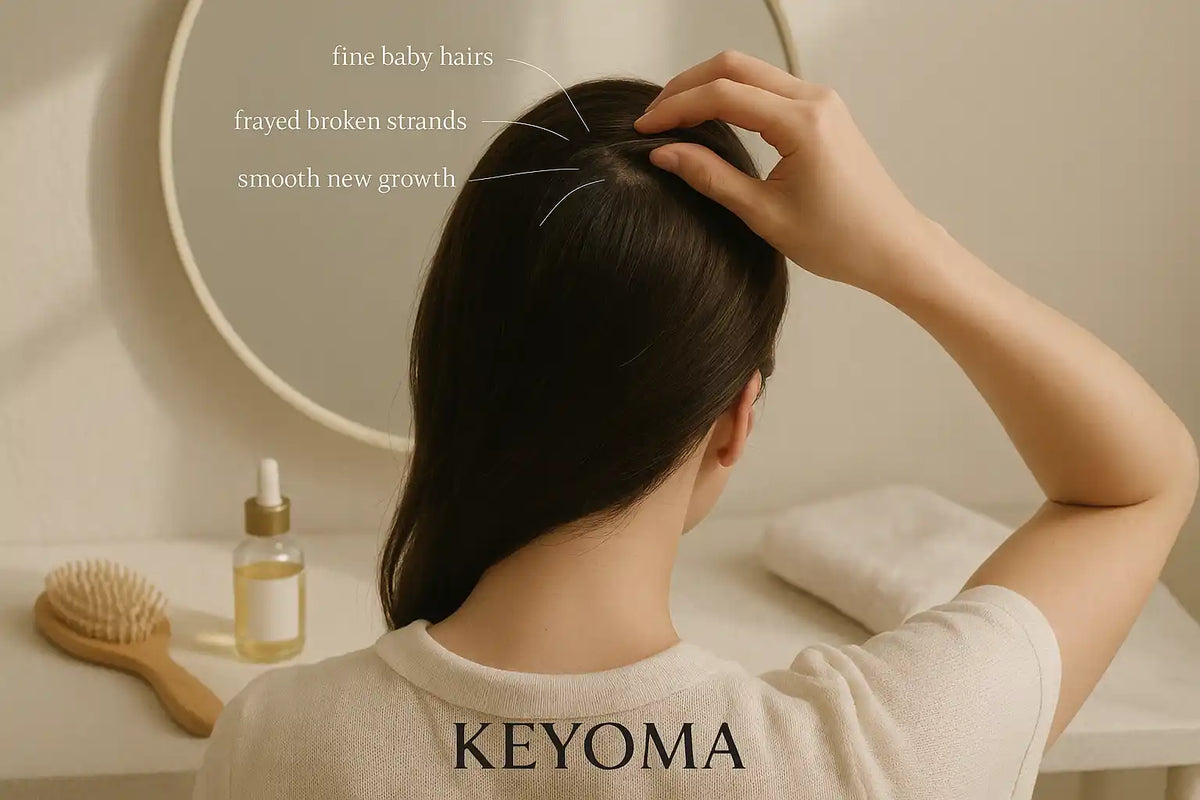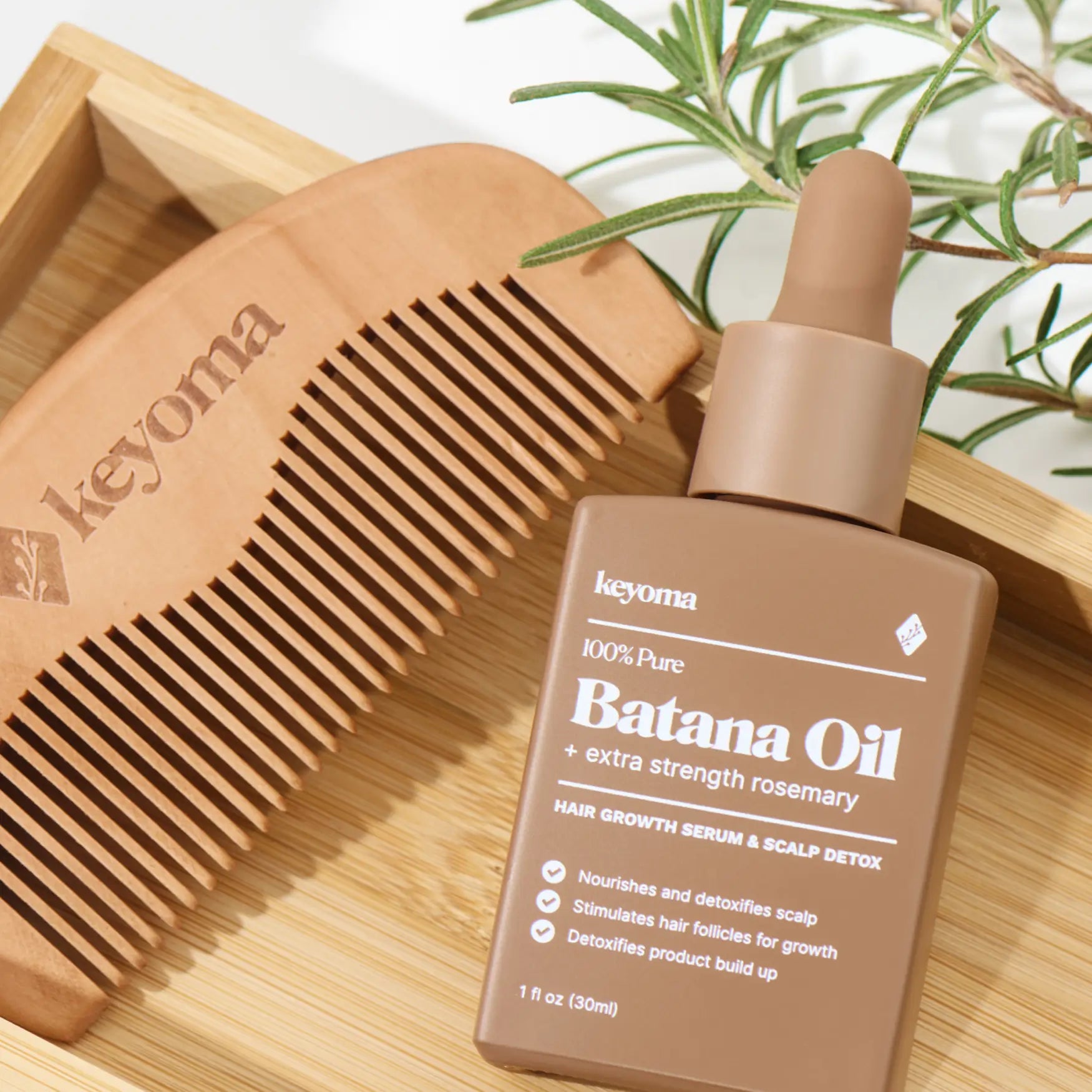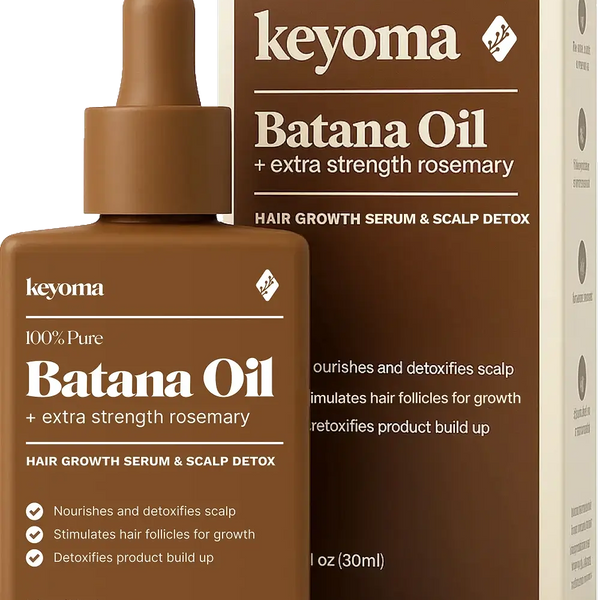In this article
I used to think every flyaway meant my hair had snapped or split. When I asked my stylist how to fix the breakage, she surprised me. She said those flyaways weren’t broken strands—they were new hairs growing in.
That changed how I saw my hair. I realized the short pieces I’d been blaming were signs of growth, not damage. That moment made me rethink everything I thought I knew about breakage, regrowth, and baby hairs.
To get clear answers, I reached out to hair professionals. I asked them how we can spot the difference between damage and growth, and how we should care for each one.
How to Know If It’s Breakage, Growth, or Baby Hair

Baby Hair
You can tell breakage, new growth, and baby hairs apart by looking at where they are and how they look. Baby hairs usually sit near the hairline or the nape of your neck. They rarely grow longer than a few inches. These fine strands, also called vellus hairs (Latin for wool), look soft, wispy, and often appear lighter than the rest of your hair.
Breakage
You’ll usually spot breakage in areas where your hair faces the most stress—like sections damaged by bleach, repeated heat styling, or tight ponytails and buns. Breakage looks different depending on how the damage happened. You might see split ends, thinning tips compared to thicker roots, or frayed, uneven strands. Baby hairs, in contrast, stay soft and even from root to tip.
New Growth
You can tell new growth from breakage by looking at the length and placement. New hair usually shows up evenly across your scalp and stays the same length. Flyaways in one specific area often point to breakage. New strands may stick out but tend to follow your styling efforts. In contrast, broken hairs often feel rough, have split ends, and don’t match the texture of the rest of your hair.
5 Signs Your Hair Is Damaged

If you think your hair might be damaged, there are clear signs you can check. Damage often shows up as split ends, a dry or rough texture, constant tangles, or hard-to-manage frizz.
Whether we color our hair, use heat styling tools, or wear tight hairstyles every day, these habits wear down our strands over time. Caring for our hair takes steady, small changes—there’s no quick fix for restoring damaged hair.
Here’s a breakdown of seven common signs of hair damage and practical steps you can take to help your strands recover and grow stronger.
1. Hair Feels Dry and Brittle
If your hair always feels dry or rough, there is a good chance the cuticle layer is damaged. This outer layer acts like a shield, and when it breaks down, moisture escapes quickly. What you are left with are strands that feel brittle, stiff, and hard to manage.
You might try conditioner or use hydrating products, but they often do not seem to help much. That is because your hair cannot lock in the moisture—it just slips right out.
And here is another clue. If your hair dries unusually fast after washing, it may be struggling to hold onto hydration. That quick-dry effect is often a red flag.
2. You Notice More Split Ends
When your strands start to fray, your ends dry right after washing, or you see thinning along the edges, you're likely dealing with split ends. Exposure to harsh weather and lack of hydration can also trigger splitting and breakage. Regular trims and steady moisture can help you get rid of split ends and keep your hair looking healthy.
3. Hair Looks Dull or Flat
When your hair starts to look dull and lifeless, it is often a sign that something is not quite right. Most of the time, damaged cuticles are to blame. These outer layers help reflect light, and when they wear down, your strands lose that healthy-looking shine.
A few common culprits include pollution, harsh sunlight, product buildup, and water with a lot of minerals. They might seem harmless at first, but over time, they take a toll.
But the good news is you can bring back the shine. It just takes a bit of care. Start by keeping your scalp clean and free of buildup. And make it a habit to protect your hair from the things that damage it in the first place.
4. Hair Breaks Easily
Pay attention to breakage paired with rough, lifeless strands. Coloring, UV exposure, and dry air often strip your hair of hydration. You might see short pieces on your clothes, in your brush, or when you touch your hair—clear signs it's snapping off. You can prevent more damage by locking in moisture with protective formulas. To rebuild damaged strands, focus on deep hydration and apply rich, restorative treatments.
5. Hair Feels Frizzy All the Time
Frizz shows up often across hair types and usually points to damage beneath the surface. If you see flyaways pop up all day and can’t keep frizz under control, your strands likely need more support. Dry air or frequent shampooing, especially near the ends, can make frizz worse. To manage it, focus on moisture and stay consistent with a gentle, nourishing routine.
8 Signs Of New Hair Growth

New hair growth shows your scalp is active and responding, but many things can shape this process. If you're treating hair loss or want to keep your strands strong, spotting signs of growth early helps.
Factors like what we eat, hormone shifts, and how we treat our hair all play a part. Understanding these can help you figure out what supports or slows new strands from forming.
This breakdown explores how your habits and biology connect to hair regrowth, offering insight into what drives progress.
1. Hair Texture Starts to Change
New strands often feel finer or smoother than the rest of your hair, showing your follicles are working well. This texture shift is usually one of the first clues that you're seeing healthy regrowth.
Supporting these new hairs with the right care—like hydrating shampoos—helps keep the process going. With consistent upkeep, you’ll notice softer, easier-to-manage hair over time.
2. Hair Feels Fuller or Thicker
Thicker hair can be a good sign that new growth is coming in, especially in areas that used to look thin. You might first spot the difference where the thinning was most noticeable. The strands start to feel fuller, and the overall volume improves. It is one of those changes that sneaks up on you—in a good way.
And when you have fewer split ends, your hair holds its shape better. That makes it look healthier and more vibrant. Regular trims and avoiding damage go a long way in keeping that momentum going. Let your hair grow, but give it the care it needs to thrive.
3. Follicles Look Darker
Noticing darker or thicker hairs at the root often means your hair is growing and recovering. This change usually shows that your follicles are getting more nutrients, which helps them produce stronger strands.
Tracking this shift helps you adjust your routine to support growth and improve results.
4. New Hair Appears Along the Hairline
When you see soft, fine hairs—like peach fuzz—appear along your hairline, it usually means new strands are forming. These early signs of growth suggest your scalp is healthy and responding well.
To help these fine hairs grow stronger, you need to feed your scalp with proper nutrients and stick to a consistent care routine. This support can turn those delicate strands into thicker, more resilient hair. To encourage steady growth, focus on:
-
Stay Hydrated: Drink plenty of water throughout the day to keep your scalp and strands moisturized.
-
Stimulate the Scalp: Use your fingertips to massage your scalp often. This boosts blood flow and encourages new growth.
-
Limit Heat Styling: Cut back on hot tools like blow dryers and flat irons. Excess heat can weaken your strands over time.
-
Apply Natural Oils: Use oils such as batana, rosemary, coconut, or jojoba will deeply condition your hair and feed it with vital nutrients.
-
Trim Often: Cut your hair regularly to remove split ends that can slow down healthy growth.
-
Eat More Protein: Add foods like fish, lean meats, eggs, and legumes to your meals to support hair structure.
-
Avoid Harsh Ingredients: Pick shampoos and conditioners free from sulphates and parabens to protect your hair from damage.
When you follow these tips, you give your hair the nutrients and attention it needs to grow strong and healthy.
5. Scalp Feels Itchy or Active
Sometimes, feeling an itch on your scalp can signal active growth beneath the surface—a common step in the hair renewal cycle. This sensation often comes from boosted blood circulation feeding your hair roots.
Although it can feel annoying, knowing it might reflect fresh hair activity helps you better understand what your scalp is doing.
6. Hair Looks Shinier and Stronger
Glossy, vibrant strands often point to new growth and signal overall wellness. This natural shine shows your hair stays hydrated and fed with what it needs to grow.
Seeing this glow can boost your trust in your routine, proving your strands get the support and nutrients required to stay strong.
7. Shedding Slows Down
Noticing less hair fall than usual can point to stronger strands and fresh growth.
By tracking how much you shed and knowing what's typical, you can spot when your hair's growth cycle improves. This awareness helps you adjust your care routine and create better conditions for your hair to thrive.
8. Scalp Feels Sensitive or Tingly
That tingling feeling on your scalp might signal active growth and renewal.
It often happens when blood flow increases and your follicles respond well to care. When you recognize this sensation as part of your hair’s recovery, you can focus your efforts and support ongoing regrowth with more intention.
Start Supporting Your Hair with Keyoma
Trying various techniques can help repair damaged strands and bring back your hair’s strength.
You need to stick with healthy hair habits and apply products that feed and support your scalp. When you stay consistent with this approach, you improve the condition of your hair over time.
Caring for your hair using the right methods and formulas leads to thicker, more resilient growth.
Featured Product
100% Pure Batana Oil + Rosemary









